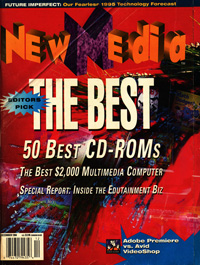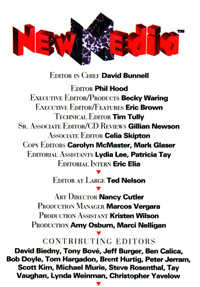|
Vaughan Family Timestream® Maps |
| Home Biography People Places Multimedia: Making It Work On the Water Writings/Presentations |
Ask the Captain
April, 1994
From "Ask the Captain," a monthly column by Tay Vaughan.
New Media Magazine.
Q. I am a professional writer of corporate video scripts. I am very interested in learning to write for Multimedia/Interactive Video. After much research, I still haven't a clue where to find the knowledge I need. Any thoughts?
Dan Marchetti, Chicago, IL
A. You will be pleased to hear that most of the creative skills you currently use when writing a video script are applicable to working with interactive multimedia. In script writing, you design a flow of events that contains detailed descriptions of scenery, actions, people, and dialog. The video then produced from your script is the vehicle that delivers your messages, your meanings, and vicarious experiences to the viewer.
Designing an interactive multimedia work is analogous to writing a video script. The task requires you to spend similar effort organizing your messages and content, with the major difference being the nature of the medium. For video, you organize your material into a linear sequence of images and sounds unalterable by the viewer but effective in getting your message across. For the multimedia medium, you organize your material into a choice-navigable structure (designed by you) that brings those messages to the end-user through interaction.
You will need to learn some new tools and their capabilities and constraints just as you did in video. Reading magazines such as NewMedia is a good place to start, short of purchasing a lot of hardware and software and jumping onto some very steep learning curves.
The really unique new element offered by interactive multimedia, however, is this choice-navigable structure, the branching tree upon which you hang the many text, graphics, audio, and video elements that carry your message.
There is no developed body of knowledge or time-tested set of rules about how you should build this tree. With interactive multimedia still in its infancy, designers are trying many different and often very creative methods for parsing their elements and organizing their messages with user choice and navigation in mind. The proof will be in which of these models end up actually working well, their success likely measured by profit in the consumer marketplace.
Information about basic structures ("this is a tree, here are the branches") is available in many of the multimedia texts on bookstore shelves (try my own Multimedia: Making It Work from Osborne/McGraw-Hill). Look for local college and continuing education programs about multimedia to help you become familiar with terms and tools. Run some existing multimedia titles and see how they are put together -- many electronics stores like The Good Guys or Circuit City have kiosks where you can play with CD-I and PhotoCD titles. In the end, do what you do now, and grow your own multimedia tree from your creative visual and audio ideas.
---
Q. Dear Captain: I've got a great idea for an interactive CD-ROM (Sorry, but I can't tell you what it is--top secret!), and I have a developer interested. I won't be actually authoring the final product, but I'm expected to come up with a fairly detailed map or storyboard of every screen, showing the hierarchy between the screens. I started doing this on paper, but I'm no draftsman, and I keep making changes. Is there a relatively easy computer-based tool that can be used to come up with such a prototype? All I need is the ability to add text, headlines, a few sample graphics (or at least place-markers for same), and the ability to create clickable buttons.
A. Like an iceberg, much of a multimedia project lies under the surface, invisible to the end user but terrifically important. The

